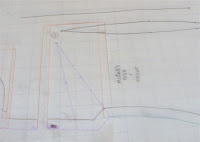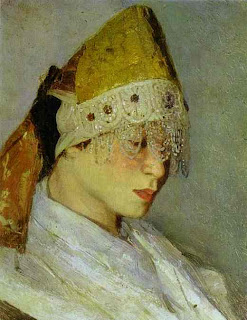| As with the front, start by analyzing the dart control. In this case, it's much simpler than the front: a single waist dart and it looks like the shoulder dart is rotated out in the yoke. |  |
| OK, here I compare the back yoke piece, already altered (see part 1) with a 3/4 inch narrow shoulder adjustment. I realize I need to make a narrow back adjustment. Look at the bottom of the photo: pattern in blue, sloper in red. |  |
| You can see the 1/2 inch I've removed from the center back. |  |
| Realizing I have not rotated out the back shoulder dart, I mark a line to separate out the back yoke. |  |
| Back yoke of sloper detached. Slash line to rotate out the dart marked in green. |  |
| I've rotated out the shoulder dart and trued the shoulder seam on the sloper. |  |
| Comparing the altered back yoke pattern (in blue) to the sloper yoke (in red), things are looking pretty good. The pattern is a little wider, but I've had my suspicions about my sloper, thinking it needs to be a tad wider at the back armhole. It's the rounded shoulder thing from doing too much work at the computer. |  |
| Comparing the altered back yoke to the main back pattern piece, I realize the same thing as I realized in the front - I need to carry the narrow shoulder adjustment down into the main back piece. Assessing how low the pattern armhole looks, I think I'll need to a petite armhole adjustment on the back too. |  |
| Just like in the front, I draw a box around the armhole with lines parallel and perpendicular to the grain. |  |
| 3/4 inch narrow shoulder adjustment on the main back piece. |  |
Marking the slash line for the petite armhole adjustment.
|  |
| Petite armhole adjustment completed. It's smaller on the back than the front, about 1/4 inch. I'm getting concerned that the pattern armhole is still quite a bit lower than the sloper. Could it be that BWOF used a block with the shoulder dart rotated to the armhole and left unsewn? That is quite common, and I quite frankly hate it. You end up with all this slop in the back armhole. I'm sorry, but to me it's messy. |  |
| Had a thought. I made a larger petite armhole adjustment in the front than the back. Maybe it's time to walk the side seams and compare the length of the front to the back. They should match with this style. They don't. |  |
| After walking the seams from the waist up, I've marked a spot where the bottom of the front armhole should meet the bottom of the back armhole. |  |
| Using my curved dressmaker's ruler, I match the original curve of the back armhole. |  |
| Holding the curve at the top, I rotate it out to meet the mark where the front piece should match the back. |  |
| Armhole redrawn. |  |
| The big picture - comparing the pattern (in blue) to the sloper (in red). Observations: the waist dart is smaller, it will take up less fabric, but generally follows the lines of the sloper. Conclusion: leave it alone. Add a bit of width at the side seam for a bit more ease. Still worried about how much lower than the sloper the armhole is - leave it for the muslin - big question mark here. |  |
Related damage - the collar pieces. I took 1/2 inch out of the center back, which affects the collar pieces.
A good lesson to take is to remember that changes to one piece often affect one or more other pieces. |  |
 I should be able to finish this today - all I need to do is sew the bodice lining and insert it.
I should be able to finish this today - all I need to do is sew the bodice lining and insert it. It's the blouse pattern I altered for the two posts on using a sloper. It's cut out and fused - I'm hoping to finish it this week.
It's the blouse pattern I altered for the two posts on using a sloper. It's cut out and fused - I'm hoping to finish it this week. Hers is done except for taking in the side seam and re-doing the hem; it's mending really, not sewing. Mine needs the sleeves sewn in and the hem.
Hers is done except for taking in the side seam and re-doing the hem; it's mending really, not sewing. Mine needs the sleeves sewn in and the hem.



